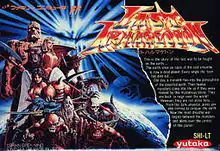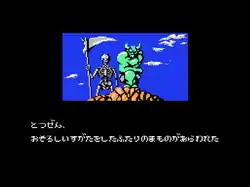Last Armageddon
Last Armageddon (ラストハルマゲドン, Rasuto Harumagedon) is a 1988 post-apocalyptic role-playing video game for the NEC PC-8801,[4] MSX, Sharp X68000, MS-DOS, PC Engine CD-ROM², and Nintendo Family Computer. The game was exclusively in the Japanese language until an English translation patch was created for the Nintendo Famicom.[5]
| Last Armageddon | |
|---|---|
 Cover art (Famicom) | |
| Developer(s) | Family Computer: Advance Communication Company[1] MSX: Braingrey.Mind[2] |
| Publisher(s) | Yutaka[1] (Famicom) |
| Composer(s) | Michiharu Hasuya, Osamu Kasai, Masaaki Harada, Hiroyasu Nishiyama (Famicom) Hiroharu Hayama |
| Platform(s) | NEC PC-8801, MSX, Sharp X68000, PC Engine CD-ROM²,[3] NES,[1] MS-DOS, FM Towns |
| Release | PC-8801 & MSX: PC Engine CD: Family Computer: |
| Genre(s) | Role-playing game[1][2] |
| Mode(s) | Single-player |
Described to be the antithesis of the Dragon Quest series, the introductory story deals with life after all organisms (humans and animals) have been wiped out by a mysterious force. All of the music in this game is considered to be representative of Hiroharu Hayama's early works; he was a composer for Japanese video games during the late 1980s and early 1990s. Hayama often used his music to make games feel spooky and dark.
The game had a sequel, After Armageddon Gaiden, released for the Sega CD in 1994.[6] Working Designs planned to release the game in North America as A Side Story of Armageddon in 1995, but the localization was cancelled due to the demise of the Sega CD system.[7]
Story

The humans, who breathed the toxin-filled air on Earth's surface, became one with the Earth and kept dissolving. The history of humanity ended and dominion of the planet returned to the demons.[8] These mutant creatures did not depend on oxygen to survive.[8] Therefore, they were able to breathe the air and use the land.[8] Meanwhile, an army of robots wage World War IV against the demons in order to conquer what is now known as Makai - the Demon World.[8] These robots came to the planet on a wave of energy that created an explosion that turned the world into a wasteland.[8] Much later in the game, concurrent themes including Adolf Hitler,[9] war,[9] creating a perfect race of people,[9] and the destruction of humanity in the year 1999 are revealed to the player inside one of the robot's main bases.[9]
Can the demons gain dominion on the humans' old planet or will robots impose a millennium of logic and dictatorial force throughout Makai? Playing as the robots is not an option open to the player. Therefore, the player must take advantage of their mutant army and crush the robot invaders. The game builds on the theme of an impending world domination through machines, as popularized famously in the Terminator series. The gameplay is similar to Final Fantasy featuring turn-based fights viewed from a third-person perspective.[8]
Gameplay
Both the demon soldiers and their enemies may cast magic spells or physical attacks.[8] Some magic attacks have the ability to inflict poison damage on any of the player's creatures. If a creature is poisoned, the player must spare some of their creature's magic points in order to cure the affected monster through the "Kuizzu" (キーウッズ) spell. Letting the creature remain poisoned for a certain amount of time will eventually lead to its death.
The game plays like a role-playing video game and graves of fallen demons by the home base remind the player of the situation of the game. When a player first starts the game, they should not go to the right, as experienced monsters lie there in a stadium-shaped power station that is in the southeastern corner of the map. It will take a foursome of level 5-10 characters in order to defeat the robots inside the dome. As characters advance in level, the monster images change slightly.[8] By the time the characters advance to levels 17 through 34 (the maximum possible levels), the monsters will look completely slimy and the fusion of the cells will get ugly.
There are two groups of four monsters that the player controls; a "daytime" group and a "nighttime" group. After it becomes night in the game, the daytime group becomes inactive and the nighttime group takes over. However, there is no HP/MP replenishment when a group becomes inactive until the next morning or night phase. Although monsters can use their healing spells to cure conditions like poisoning, there is no known way to cure HP in the game other than via items spread throughout the dungeons in the game, or by using the magic spell "Shell Key" (シェル・シェルキー).
Version differences
The Nintendo Family Computer version lacks the monster encyclopedia that exists in the other versions of the game. None of the background music in the game resembles that of the PC Engine or the FM Towns version. This was most likely because the Famicom version was not only developed by a different company, but also because four different people worked on the soundtrack.
Two versions existed for the FM Towns version; a "large memory version" with normal levels of animation and the "small memory version" with slightly reduced levels of animation. The FM Towns version also comes in a series of three CD-ROMs and requires 1 megabyte of RAM (for the low memory version) and 2 megabytes of RAM (for the high memory version). Only one character can be equipped with the most powerful sword (Azotto) and this person is pre-determined by the game itself. A 3.5" floppy disk is needed to save the game; which had to be purchased separately from the game.
In the PC Engine version, all the 3D maps are shown as flat two-dimensional dungeons. Only goblins and orcs can be equipped with swords, unlike in the other versions. Transition time between "daytime" and "nighttime" characters has been eliminated in the PC Engine version, leading to an immediate swap of characters.
References
- "Release information (NES)". GameFAQs. Retrieved 2008-04-28.
- "Release information (MSX)". GameFAQs. Retrieved 2008-05-24.
- "Release information (TurboGrafx-CD)". GameFAQs. Retrieved 2008-05-15.
- Last Armageddon (Translation), 4Gamer.net
- http://www.romhacking.net/translations/2783/
- "After Armageddon Gaiden". RPGamer. Archived from the original on 13 August 2017. Retrieved 29 January 2012.
- Pettus, Sam (July 15, 2004). "Sega CD: A Console too Soon". Sega-16. Archived from the original on January 14, 2010. Retrieved 2009-12-17.
- "Summary". MobyGames. Retrieved 2008-04-28.
- "Game content". Moemoe. Retrieved 2008-04-28.